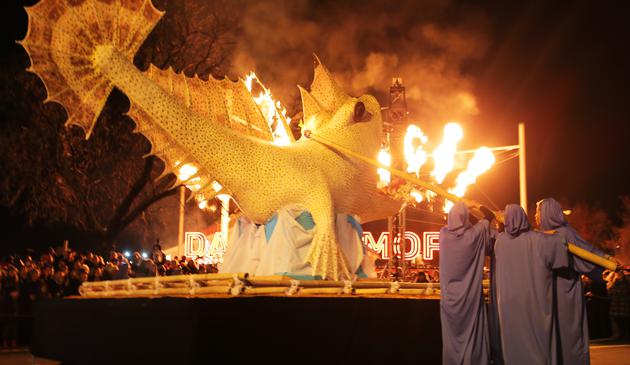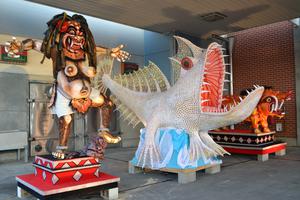
Ogoh-ogoh made for Dark Mofo 2015, including the Spotted Handfish.
The story of the ogoh-ogoh ritual in Dark Mofo started at UTAS in 2015.
“We were thinking about what we could do with students in winter in relation to myths and beliefs,” explains Dr Kaz Ross, Coordinator of Asian Studies, Global Cultures and Languages. Graduate Cas Charles was connected to community art in Bali and suggested a focus on the ogoh-ogoh tradition, which involves the building of giant 'monster' sculptures. The idea was put to Dark Mofo, and the project soon also became a collaboration with UTAS' School of Creative Arts.
The local Indonesian community and the Indonesian Consul General have also enthusiastically embraced the Tasmanian ogoh-ogoh tradition, and now lead the procession through Hobart’s streets.
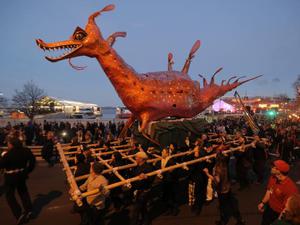
The weedy seadragon in the ogoh-ogoh procession at Dark Mofo 2016.
Transforming a tradition
In Bali, artisans build large figures of demons or mythological beings. The ogoh-ogoh, and the bad spirits with them, are taken out of town and burnt in a purification ritual on Nyepi, which is new year's eve. The next day is the Day of Silence, a time of contemplation and renewal.
In Tasmania, the burning occurs on or near the eve of the winter solstice, a night of celebration according to pagan tradition. The following day is one of self-reflection. Particular to the Tasmanian ritual is the idea of burning fears. Festival-goers visit the ogoh-ogoh in the days before the procession and write down their fears on joss paper, which is subsequently burnt along with the creature. Kaz Ross elaborates:
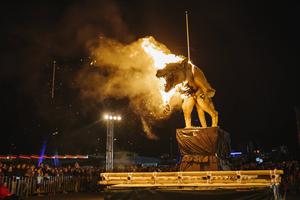
The Tasmanian tiger burning at Dark Mofo 2017.
Last year, we had 14,000-15,000 fears written. Some people write whole essays, others discuss with us what their fears are. The process of contributing... seems to create a wonderful connectedness.
The originator of the idea of bringing the ogoh-ogoh to Hobart, Cas Charles, agrees. “I believe that different world views can find common ground through community ritual. This opens a space for mutual understanding and cultural acceptance.”
Kaz Ross says the idea was always to blend traditions:
We wanted to create a ritual around banishing fears, and of course one of the biggest fears of our age is the environmental impact of humans and planetary extinction.
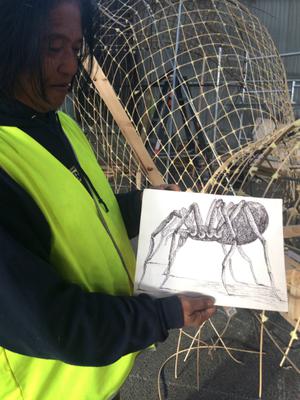
Working sketch of the cave spider, used for the 2018 build.
It was decided that the ogoh-ogoh would be Tasmanian animals, to symbolise the demon of potential environmental harm.
The first creature was the critically endangered spotted handfish, enhanced with dangerous-looking, outsized teeth. The following year there was an intricate, trailing weedy seadragon, then a leaping Tasmanian tiger.
This year’s ogoh-ogoh is a giant Tasmanian cave spider, a long-lived species found nowhere else on earth.
Building a monster
On the first day of winter 2018, three Balinese artists can be found working in a cavernous shed on Hobart’s waterfront. They weave rattan and assemble bamboo strips in a criss-cross framework.
The vast spider – nine metres long and with moveable legs – is starting to take shape.
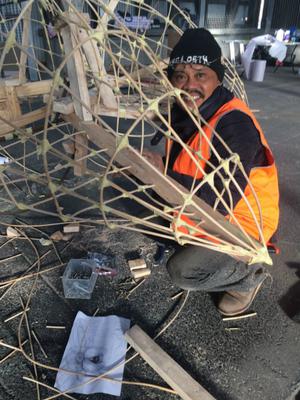
Ikomang Sedana Putra building the spider for Dark Mofo 2018.
For Ida Bagus Oka, Ida Bagus Antara and Ikomang Sedana Putra, who come from the village of Mas in Bali, building and enacting the ritual of the Ogoh-ogoh in Hobart is now familiar. Ida Bagus Oka, a mask maker of renown, explains what motivates him to be involved:
This Hindu tradition would be difficult to explain because it’s so deep and wide. But by coming here, we can show this tradition. And we can share it.
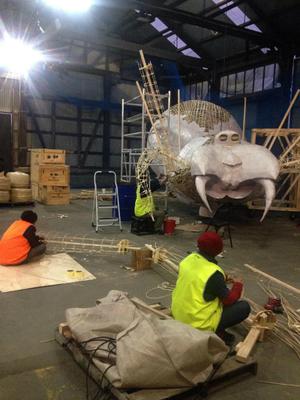
Building the spider for Dark Mofo 2018.
Once the structure is complete, it will is covered with papier maché and towelling, to give it texture, and later will be carved and painted. Here, Ida Bagus Antara a temple statue maker, and Ikomang Sedana Putra, a painter, will be working intensely.
For the artists it's a daunting task, and will be undertaken in only about two weeks. Ida Bagus Oka explains:
This is the biggest ogoh-ogoh we’ve ever made. But everything is difficult before we start it.
This is the first Dark Mofo ogoh-ogoh that’s large enough to need a metal frame (courtesy of Cygnet artist Dan Laughlin). The 250kg beast will be suspended from a web when people visit it to post their fears.
A prehistoric marvel
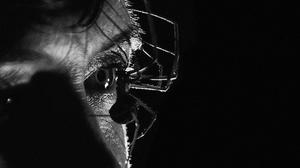
UTAS' Cave spider expert Dr Niall Doran has made an award-winning film about these incredible creatures. Sixteen Legs will screen on 23 June as part of Dark Mofo. Photo by courtesy of the Bookend Trust.
The Tasmanian cave spider, Hickmania troglogytes, is a relic of the time of the supercontinent Pangea and is a species that has survived little changed for hundreds of millions of years.
It is unique in many ways. For instance, individual spiders survive for decades. Eggs take nine months to hatch. The spiders’ bodies are 2cm long, but their legs may sure up to 18cm each, making the whole creature as large as a dinner plate.
While these spiders are relatively abundant in Tasmania, they are found only here – their closest relatives are in Chile – and degradation of environments on the surfaces around caves may threaten their future.
This year's ogoh-ogoh procession and burning takes place on 24 June as part of Dark Mofo.
Study Indonesian as part of Global Cultures and Languages at UTAS.
The University of Tasmania's Asia Institute supports an extensive schools program on Indonesian language and culture which is conducted by Cas Charles with visiting Balinese artists.
Hero image: Photo by UTAS. Balinese artists Ida Bagus Oka, Ida Bagus Antara and Ikomang Sedana Putra.
